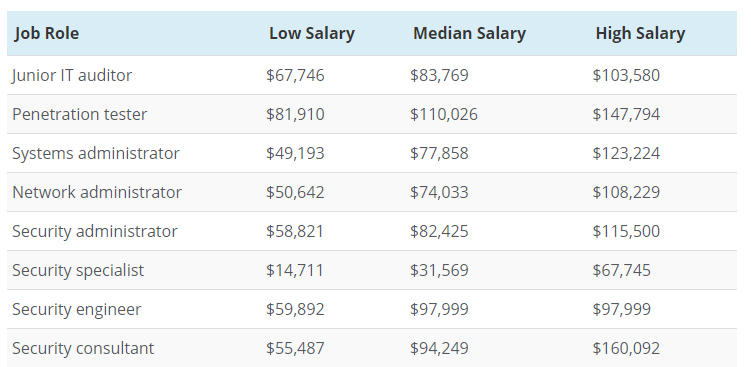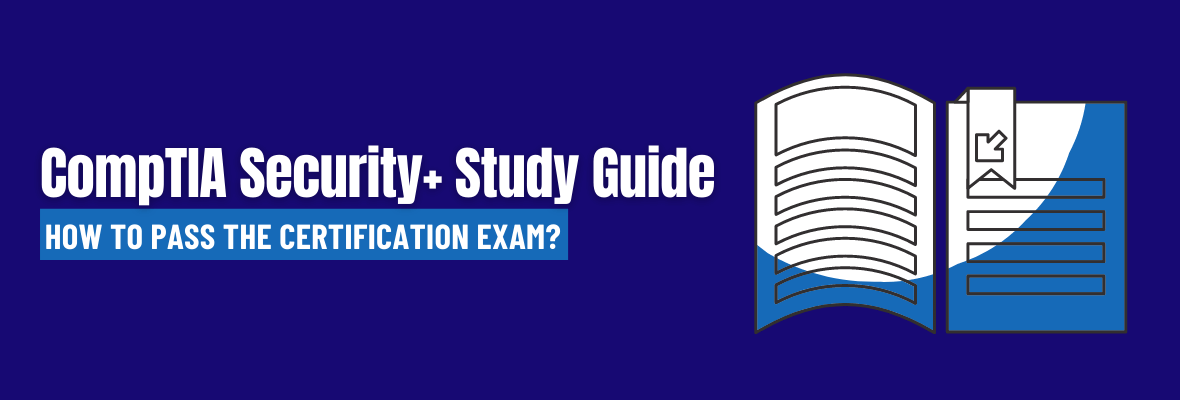CompTIA Security+ Study Guide: How to Pass the Certification Exam?
If you’re working in the cybersecurity sector, there’s no shortage of certifications you can pursue to advance your career.
We’ve come up with a comprehensive CompTIA Security+ Study Guide, so you don't have to spend hours exploring the nuances of the CompTIA Security+ Certification. This guide will provide you with insights to pass the CompTIA Security+ exam in one go.
But before that, you should understand the perks of this certification.
Why Should You Get a CompTIA Security+ Certification?
Cybersecurity is one of the most crucial and fastest-growing IT specializations. Organizations are keen to hire professionals with fundamental IT security expertise. CompTIA Security+ is one of the most widely accepted vendor-neutral certifications to validate you have the basic skills to perform core security functions and protect networks and security data.

Source: Specops Software
The CompTIA Security+ Certification deals with fundamental concepts in IT security, such as:
- Host security
- Threats and vulnerabilities
- Cryptography
- Access and identity control
- Compliance
The CompTIA Security+ Certification helps you acquire skills to respond to incidents and minimize risks before they occur. While anyone willing to pursue a career in cybersecurity can earn this certification, it’s best suited for IT administrators and security professionals.
Now that you know the basics, let's move to the next part of this CompTIA Security+ study guide. It covers the CompTIA Security+ exam pattern.
CompTIA Security+ SY0-501 vs SY0-601: What’s the difference?
To cope with the evolving technological era, each CompTIA Security+ Credential is valid for three years, after which a newer version of the exam is released by CompTIA.
In 2017, the CompTIA Security+ SY0-501 exam was released. SY0-601 is the most recent exam, released in 2020. The major difference between the exams is that the SY0-601 is a trimmed-down version of SY0-501, and covers five domains rather than six.
SY0-601 has 35 CompTIA Security+ objectives whereas SY0-501 has 37, which means the newer version has more examples within each objective and focuses on depth over breadth.
SY0-601 is an updated version of the exam, but a major benefit of taking the SY0-501 exam is that you’ll find ample online study resources in addition to CompTIA official study material.

Source: CompTIA
There are no strict prerequisites to earn a CompTIA Security+ Certification. CompTIA suggests individuals have either a prior Network+ Certification from CompTIA or 2 years of network security administration experience.
The duration of both exams is 90-minutes, and there are 90 performance-based (PBQs) and multiple-choice questions. PBQs assess your ability to answer problems in a simulated set-up, usually an approximation of a virtual environment like a network diagram, operating system, firewall, and network window.
To pass the exam, on a scale of 100-900, you must score a minimum of 750. While taking the exam, you aren’t allowed to leverage any physical writing tools such as a pen/pencil, scratch paper, erasable whiteboards, or any exam-specific material.

Source: Netwrix
A CompTIA Security+ credential opens the doors for several CompTIA Security+ jobs, as many notable employers are looking to hire professionals for roles like:
- Network Administrator
- Security Administrator
- System Administrator
- Junior IT Auditors
- Penetration Testers
- Security Engineer/Analyst
- Help Desk Manager/Analyst
- Network/Cloud Engineer
- DevOps/Software Developer
- IT Project Manager
Along with a variety of roles, CompTIA Security+ job salary range is also lucrative. As of 2021, the average yearly salary of a CompTIA Security+ entry-level role is $59,009, which increases with the experience level of the professional.
Notable employers like the US Army, Fayetteville Technical Community College, the US Air Force, and South-eastern Louisiana University recommend and hire CompTIA Security+ professionals.
Getting CompTIA Security certified can pay off handsomely, but what about passing the exam? Let’s explore steps you must follow to pass the CompTIA Security+ Certification exam:
7 Crucial Steps to Passing the CompTIA Security+ Certification Exam in One Go
Like every other professional certification exam, CompTIA Security+ isn’t easy to pass. We’ve gathered some tricks in this CompTIA Security+ Study Guide that’ll help you determine which specific areas you must pay the most attention to, so you can pass your exam in the first attempt.
1. Assess Your Current Knowledge & Skills: Although not mandatory, it is recommended that you have two years of prior experience in IT administration with a focus on security before attempting the CompTIA Security+ exam. To pass the CompTIA Security+ exam, prior experience in performing tasks, like recognizing threats, tracing intrusions, risk management, conducting penetration testing, and risk mitigation would be helpful.
2. Craft a Study Plan and Make Sure to Stick to It: The best way to prepare for the CompTIA Security+ exam is to create a study plan. To resume Security+ SY0-501 exam preparation the CompTIA Security+ Certification Exam Objectives could be your best alternative. It acts as a roadmap to assess your progress through the curriculum as you prepare for the test and elaborates the goals of the certification.
3. Keep a Good Study Guide Handy: The official CompTIA textbooks and study resources would be most helpful while preparing for the Security+ exam. The Official CompTIA Security+ Study Guide, which costs $149 and is available in eBook format, is the best study resource.
4. Participate in Online Security+ Communities: If you want to stay motivated while preparing for the CompTIA Security+ exam, the best solution is to join an online Security+ community and study with like-minded individuals. Here, experts share their insights and test-takers can get their doubts resolved.
5. Sign-up for an Online Security+ Bootcamp: Bootcamps are intensive training sessions that help you prepare quickly for the CompTIA Security+ exam concepts. There are several 3-4 day bootcamps where you can learn the exam topics in detail with a variety of study materials.
6. Take Practice Exams and Analyze the Responses to Questions You’ve Skipped: Taking practice exams allows you to figure out the areas where you lack knowledge, so you can concentrate on them better. The CompTIA Store is the place where you can find the practice exams. Keep in mind, the duration of the CompTIA Security+ exam is 90-minutes and you need to solve 90 questions. Time your practice exams and formulate a strategy accordingly.
7. Refrain from Getting Trapped in “Brain Dumps”: The real exam questions for the CompTIA Security+ Certification aren’t available anywhere online. However, you can take the practice tests to get an idea of what you can expect in the actual exam. Now that you know how to prepare for the CompTIA Security+ exam, let’s explore some tips and tricks to crack it in this CompTIA Security+ Study Guide.
Some Useful Tips for Passing the CompTIA Security+ Exam
Focused training, proper preparation, and consistent practice are the crucial tips that help you crack the CompTIA Security+ exam. Along with these three, we’ve compiled a few more tips in this CompTIA Security+ Study Guide to help you prepare better and succeed in the exam.
1. Understand Information Covered in the CompTIA Security+ Exam: You must know what all concepts are covered in the Security+ exam. By understanding the core concepts, you’ll identify which specific topics you know well, which you need to revise, and where you require help.
2. Identify Your Strengths and Weaknesses with Practice Tests: Taking practice tests helps you assess your preparation as they have a series of questions you can expect in the Security+ exam. You can review your readiness and assess the overall preparation, plus your knowledge within each domain, to identify what concepts you know and which ones need more preparation.
Factual and theoretical knowledge isn’t enough to pass the Security+ exam. Taking practice tests helps you solve the performance-based and multiple-choice questions that are an integral part of the exam. They test your capability to solve problems in a simulation. Such questions validate your ability to implement the knowledge that you’ve learned in the practical world.
3. Enhance Your Knowledge Gaps: After you’ve identified the areas where you need additional help, taking a formal training course would be the best plan to implement that knowledge. When picking a training course, ensure that the provider is CompTIA-authorized.
Formal Security+ training ensures:
- You’re learning from a professional who is an expert. They should have the experience to enhance their skills to answer the exam’s challenging performance-based and multiple-choice questions.
- You’re collaborating with an institution that’s authorized and continuously audited by CompTIA.
- You have access to Security+ exam objectives, approved courseware, labs, best practices, and the latest information.
4. Get Ready for the Exam: Once you’ve finished formal training, take your time to review the materials and focus on the areas that weren’t as familiar to you. You aren’t allowed to bring any reference material to the exam. Go through all the labs included in the course and review the key terms, so you are confident when answering the multiple-choice and performance-based questions.
Once you are done with preparation, you can schedule your CompTIA Security+ exam, which is administered by Pearson VUE. The CompTIA Security+ exam cost is $370 and can be taken either online or offline. On the Pearson VUE website, you can easily register for the exam and can reschedule, if needed.
5. Take the Exam: When you finally take the exam, relax and read each question cautiously. A reading error might lead you to answer a question wrongly. The duration of the exam is 90-minutes, but you can skip a question and return later to answer it. Your responses will be analyzed immediately and, if you’ve passed, you’ll receive a confirmation of your achievement. You have an option of receiving a physical copy of your accomplishment, in case you want to display it on LinkedIn.
Sample Questions
The CompTIA Security+ Study Guide will be incomplete without exploring some of the sample questions for the Security+ exam. They include:
Q1. The procedure of proposing a user ID to a validating system is called…
- Identification
- Authentication
- Authorization
- Single sign-on
Q2. Which of the following, if used, would BEST minimize the number of successful phishing attacks?
- Two-factor authentication
- User training
- Mantraps
- Application layer firewall
Q3. Assume a system administrator is setting up accounts on a recently established server. Which attribute BEST differentiates service accounts from other types of accounts?
- They can often be restricted in privilege
- They remain disabled in operations
- They do not allow passwords to be set.
- They are meant for non-person entities
- They require special permissions to OS files and folders
Q4. A coworker asked Joe, a security analyst, “What’s this AAA concept all about in the security world? It sounds like something I can use for my car.” Which of the following terms should Joe talk about while giving a response to his co-worker? (Select any THREE).
- Accountability
- Authorization
- Accounting
- Authentication
- Access
- Agreement
Q5. Of late, an organization has been facing a problem with shoulder surfing. Which of the following precautions would be useful in such a situation?
- Biometric authentication
- Video cameras
- Smart cards
- Screen filters
Q6. A security engineer wants to implement a site-to-site VPN that will require SSL certificates for mutual authentication. Which of the following will you choose?
- L2TP/IPSec
- SSL VPN
- PPTP VPN
- IKEv2 VPN
Q7. An input field accepting extra data than has been allotted for it in memory is a trait of:
- Resource exhaustion
- Memory leak
- Buffer overflow
- Cross-site request forgery
Q8. An organization has built a bespoke solution for booking airline tickets. What would you term it if a freelance coding expert tests it for security discrepancies?
- Dynamic code review
- Regression testing
- Static code review
- Code review
Answers:
Q1. A, Q2. B, Q3. D, Q4. B, C, D, Q5. D, Q6. B, Q7. C, Q8. B
Want To Get CompTIA Security+ Certified? Join a Bootcamp Today!
